In this article, you’ll learn What is Fuel Injection Pump? Its diagram, parts, working, types, and Symptoms all are explained with pictures.
Also, you can download the PDF file at the end of this article.
What is Fuel Injection Pump?
As the name implies, a fuel injection pump is a device in an automobile that pumps fuel into the cylinders of a gasoline or diesel engine. The injection pump is driven indirectly from the crankshaft by a gear, chain, or timing belt, which also operates the camshaft.
It is usually attached to the camshaft so that they are interconnected. In four-stroke engines, the injection pump rotates at half the speed of the crankshaft to allow the correct injection process timing when the cylinder’s compression stroke is about to begin.
This differs from a fuel pump, which is required for fuel to flow from its container or fuel tank. It is part of the system that pumps fuel to the engine block from the tank. Then, the injection pump pushes the fuel inside the cylinder.
It helps deliver precise fuel, which maintains a rhythm or timing and keeps the engine running smoothly. Also, the pump controls the amount of fuel required to achieve the desired power. It serves as both the throttle and ignition system required in gasoline engines.
Read Also: What is the function of a fuel injector in a diesel engine?
Parts of Fuel Injection Pump
Following are the main parts of a fuel injection pump:
- Delivery valve
- Distributor plunger
- Pressure control valve
- Governor assembly
- Overflow restriction
- Distributor with high-pressure pump
- Vane-type fuel-supply pump
- Timing device
- Cam plate
- Electromagnetic shutoff valve
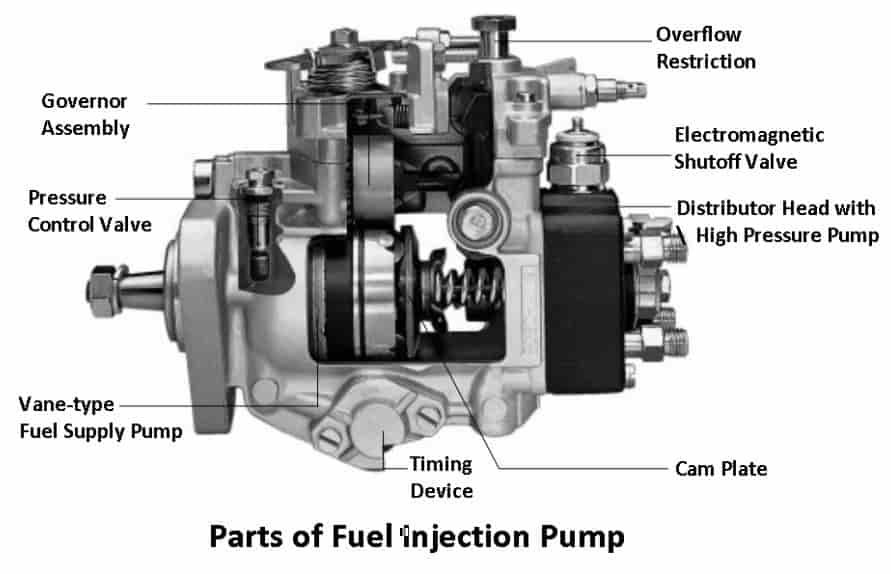
#1 Delivery Valve
A delivery valve is used to deliver fuel to the injectors mounted above the EFI pump. A delivery valve controls pressure waves inside the fuel line and is a non-return valve.
#2 Distribuor Plunger
With a fuel injection pump plunger, fuel injection can be controlled according to engine load and can be used to reduce exhaust smoke and achieve quieter engine operation. It also enables the engine to regain speed rapidly under full load.
#3 Pressure Control Valve
A pressure-control valve is employed to maintain the injection-pump internal pressure as a function of supply-pump speed. With this valve, it is possible to set a specified pressure for a given speed.
#4 Governor Assembly
The governor assembly consists of a mechanical flyweight governor and is driven by the drive shaft. The governor containing the control, starting, and tensioning levers can pivot in the mechanism housing.
It is attached to the governor shaft, fixed in the governor housing, and free to rotate around it. When the flyweights rotate, they rotate outward due to centrifugal force, and their radial movement is converted into axial movement of the sliding sleeve.
#5 Overflow Restriction
It screws into the governor cover of the injection pump and is attached to the interior of the pump. This allows a variable amount of fuel to return to the fuel tank through a small passageway. The restriction means the flow resistance that helps maintain pressure inside the injection pump.
#6 Distributor with High-pressure Pump
It is important to understand that the purpose of the distributor’s head with the high-pressure pump is to generate injection pressure and deliver and distribute fuel to the engine. In this, the plunger goes inside the distributor’s head, which is attached to the pump housing.
The distributor’s head consists of an electrical fuel shutoff device, screw plugs with vent screws, and delivery valves with their holders.
#7 Vane-type fuel-supply pump
Using a valve-type fuel-supply pump fitted with a pressure-regulating valve, the pump draws in fuel and generates pressure inside the pump, which drives the engine.
#8 Timing Device
The injection pump’s timing device determines when it will inject fuel into the cylinder and when the piston reaches the BTDC point. It also adjusts the start of delivery (port closing) as a function of pump speed and as a function of load.
#9 Cam Plate
A cam plate is forced against a roll ring by the spring. As the ring rotates, the cam lobes which are riding on the rollers of the ring, are able to convert the rotational movement of the drive shaft into the reciprocal movement of the cam plate through the lobes.
#10 Electromagnetic Shutoff Valve
Fuel injection pumps are equipped with electromagnetic fuel shutoff valves that function as a means of interrupting the supply of fuel to the pump.
Read Also: What are the different types of fuel filters used?
Working of Fuel Injection Pump
It is a major component of the fuel injection system that performs various functions to keep the car running smoothly. The primary function of the injection pump is to extract fuel from the fuel tank and pump it to all the injectors at high pressure.
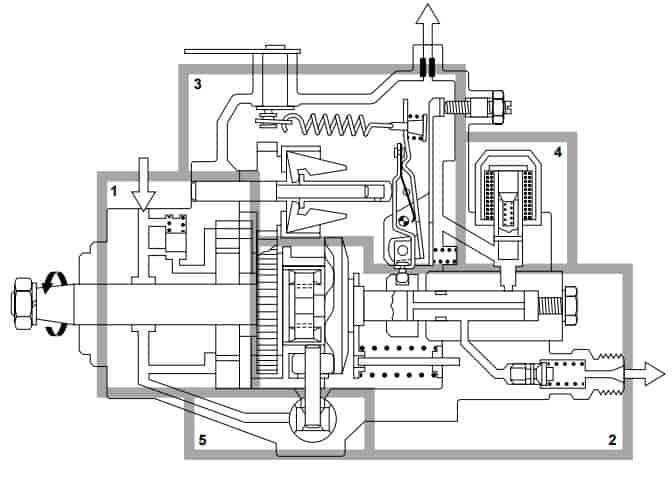
There is only one function of a fuel injection pump in an electronic fuel injection system, and that is to pressurize the fuel line. In an inline fuel injector pump, it helps measure or meter the amount of fuel supplied to the injectors.
Another crucial function of the fuel injection pump is to deliver fuel to all the injectors at precise times for combustion. In inline fuel injection, individual plungers and fuel barrels are used for each engine cylinder to supply fuel to all injectors. But in a distribution pump, the rotor allows fuel distribution to all the cylinders.
It is because of the fact that fuel injectors are directly subjected to the combustion process. Thus, the fuel injectors are exposed to a higher temperature during combustion. The fuel injection pump helps cool the fuel injectors by pumping low-temperature fuel into the injectors.
Read Also: Different Types of Cooling Systems and Their Working
Types of Fuel Injection Pumps
The following are the main types of fuel injection pumps:
- Individual Inline fuel injection pump
- Distributor fuel injection pump
- Continuous fuel injection pump
#1 Individual Inline Fuel Injection Pump
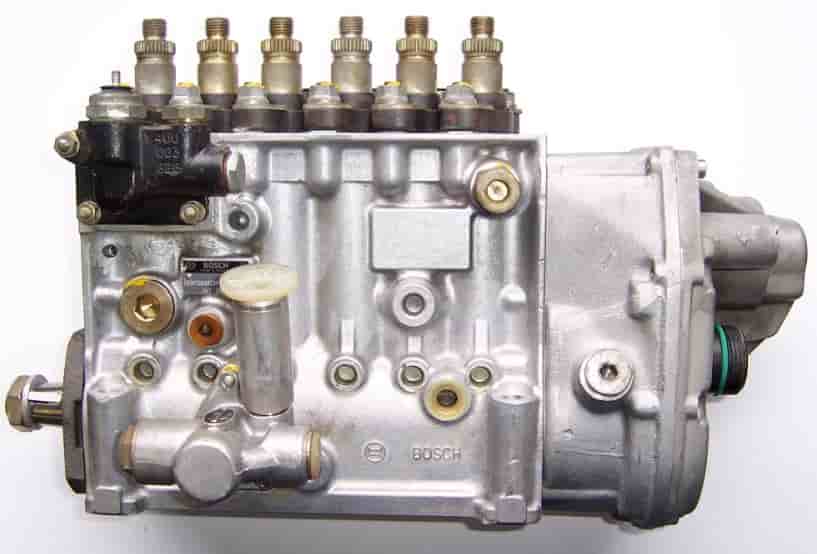
It is an individual inline injection pump in which a plunger mechanism will perform each injector. In other words, the number of plungers is the same as the number of injectors. All these plungers are installed together in a line position in a pump unit, hence the name.
The inline fuel injection pump consists of the camshaft, plunger, and fuel barrel. The camshaft has the number of cams according to the number of plungers. A plunger works to increase fuel pressure. The fuel barrel is the small space where fuel is placed to be transferred to the injectors.
When the crankshaft rotates, the camshaft pump also rotates, resulting in the rotation of the camshaft causes the cam being alternately pressed against the plunger. As soon as the plunger is pressed, the fuel pressure increases, causing fuel to be sprayed from the injectors.
#2 Distributor Fuel Injection Pump
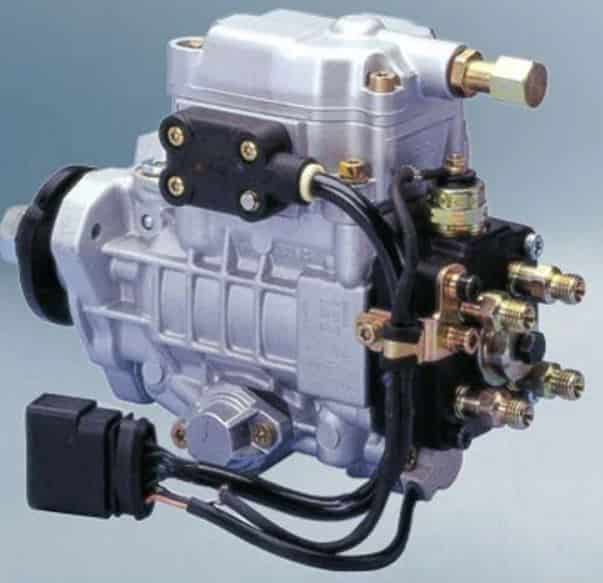
It is small in size and used as a solution for vehicles with limited space. The main part of the distributor pump is its injection system. In the inline type, one plunger is used for one injector, but in the distributor type, one plunger is used for all injectors.
In this type, a plunger will alternately pressurize all the fuel in each fuel barrel. The fuel barrel can be found somewhere around the pump shaft. Pump shaft rotation causes the plunger to alternately press the fuel in the barrel when the ignition timing changes.
Despite the small design of the distributor pump, it does not have high fuel pressure. Because of this, it is rarely used for high-capacity diesel engines.
#3 Continuous Fuel Injection Pump
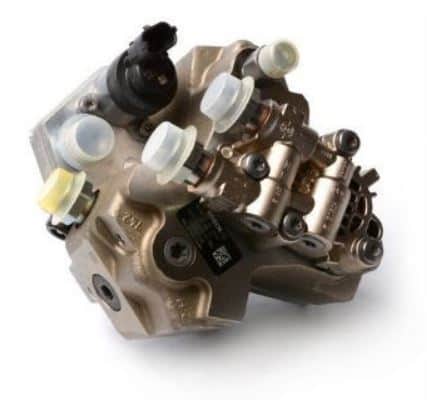
The continuous pump is a modern type used as an injection pump that is applied to the general direct injection system. In terms of size, this pump is the smallest of the other two types of injection pumps. Due to this, it has only a single function.
Its primary function is to steadily increase fuel pressure to a high-pressure range from 30,000 – 40,000 PSI. In addition to increasing fuel pressure, the above two types control the timing and amount of fuel injected. So the form should be pretty straightforward.
This pump works like a water pump because it has a turbine, although some types use membranes as well. The pump will pressurize the fuel and maintain the fuel pressure at the applicable range.
Read Also: What are the symptoms of a car thermostat and how to replace it?
Symptoms of Fuel Injection Pump
Some of the symptoms of a faulty fuel injection pump are as follows:
- Engine splutters
- Whining noise
- Lack of power
- Hard to start
- Smoky exhaust
#1 Engine Splutters
Improper fuel injection caused by a faulty fuel injection pump is one of the causes of engine sputtering noise. This type of noise is observed when the vehicle is accelerating or at high engine speeds.
#2 Whining Noise
This is also the type of noise you can hear from the fuel pump at the fuel tank location. Whining noise may arise due to a faulty fuel injection pump, or it may be due to an insufficient amount of fuel in the tank, thus making it difficult for the pump to suck up fuel.
#3 Lack of Power
In some cases, the fuel pump may not be able to provide a sufficient amount of fuel for combustion when the vehicle is overloaded. Hence the engine is unable to make a sufficient amount of power to move the load.
#4 Hard to Start
The engine is sometimes hard to start because the fuel pump is not pressuring the fuel line. Most of the time, the engine starts over, and then it stalls again.
#5 Smoky Exhaust
The reason for the smoke exhaust is that the fuel pump is supplying too much fuel to the injectors. Due to improper fuel combustion, smoky exhaust gases are observed at the tailpipe, or fuel economy is reduced.
Closing It Up
I hope I have covered everything in this article. If I missed something, or if you have any doubts, let me know in the comments. If you liked this article, please share it with your friends.
Want free PDFs direct to your inbox? Then subscribe to our newsletter.
Download PDF of this article:
You might like to read more in our blog:
- What is Ignition Distributor? Diagram, Parts, Working & Problems
- How does a hydraulic braking system work?
- Different Properties of Lubricants and Their Uses [PDF]
Resources or External Links:
FAQs
The mechanism that feeds fuel into a diesel engine’s cylinders is called an injection pump. Usually, the injection pump was powered indirectly from the crankshaft by gears, chains, or a toothed belt (typically the timing belt), which also operates the camshaft.
A fuel injection system uses fuel more efficiently, consumes less fuel, and produces fewer emissions because it can more precisely regulate the air-to-fuel ratio.
Distributor (Rotary) fuel injection pump. Inline-injection (Jerk) fuel injection pump. Continuous pump. High-pressure common rail pump.
Electric Fuel Pumps. Manual Fuel Pumps. Hand-Cranked Fuel Pumps. Digital Fuel Pumps. Retro-style Fuel Pump.
Good work
Thanks.
so informative
Thanks for reading.
Please kindly send me more on my mail
The PDF file has been sent to your inbox.